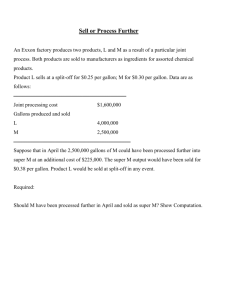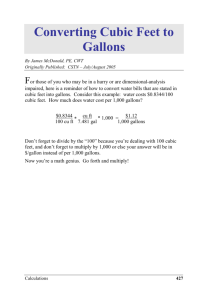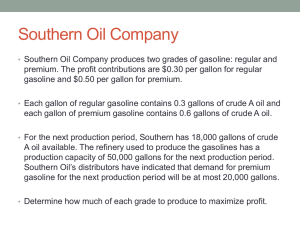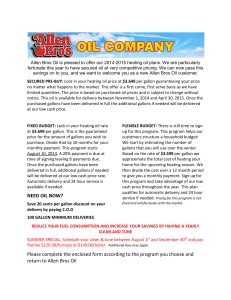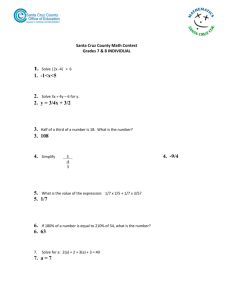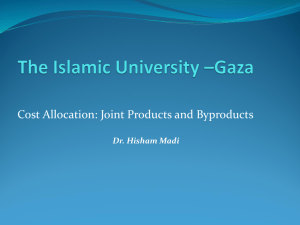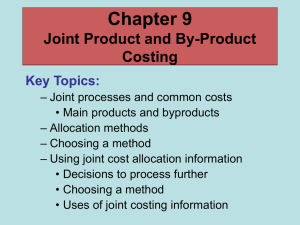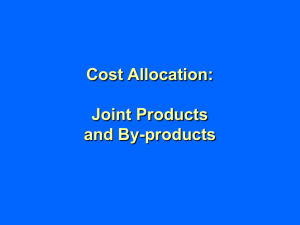Chapter 16
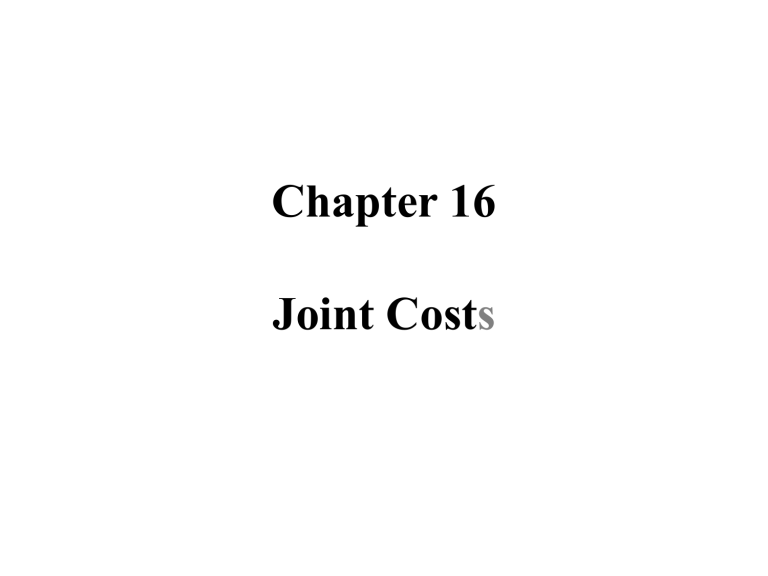
Chapter 16
Joint Cost
s
Joint
Input
Joint
Costs
Joint Products
Oil
Separate
Processing
Common
Production
Process
Gasoline
Split-Off
Point
Chemicals
Final
Sale
Final
Sale
Separate
Processing
Separable
Product
Costs
Final
Sale
Examples of Joint Cost Situations
Why Allocate Joint Costs?
• to compute inventory cost and cost of goods sold
• to determine cost reimbursement under contracts
• for insurance settlement computations
• for rate regulation
• for litigation purposes
Joint Cost Allocation Methods
• Market-Based – allocate using marketderived data (dollars):
1. Sales value at split-off
2. Net Realizable Value (NRV)
3. Constant Gross-Margin percentage NRV
• Physical Measures – allocate using tangible attributes of the products, such as pounds, gallons, barrels, etc
An Example
• Farmer’s Dairy purchases raw milk from individual farms and processes it until the split-off point, when two products – cream and liquid skim
– emerge. These two products are sold to an independent company, which markets and distributes them to supermarkets
• In May 2009, Farmer’s Dairy processes 110,000 gallons of raw milk. During processing, 10,000 gallons are lost due to evaporation, yielding
25,000 gallons of cream and 75,000 gallons of liquid skim.
• Summary data follows:
Joint Cost - Base Data For Example
Joint Process Overview
Sales Value at Splitoff Method
• Uses the sales value of the entire production of the accounting period to calculate the amount of allocation
• Ignores inventories
Sales Value at Split-off Computation
Physical-Measure Method
• Allocates joint costs to joint products on the basis of the relative weight, volume, or other physical measure at the split-off point of total production of the products
• Let’s use number of gallons produced as the measure to allocate joint costs
Physical Measure Method Computation
Further Processing – Additional Data
• Assume the same data as the base case except that both cream and liquid skim can be processed further
• Cream is processed into Buttercream: 25,000 gallons of cream are further processed into 20,000 gallons of buttercream at additional processing costs of
$280,000. Buttercream sells for $25 per gallon
• Liquid Skim is processed into Condensed Milk: 75,000 gallons of liquid skim are further processed to yield 50,000 gallons of condensed milk at additional processing costs of $520,000. Condensed milk sells for $22 per gallon
• Sales during May were 12,000 gallons of buttercream and 45,000 gallons of condensed milk.
Data for Further Processing
Further Processing Overview
Net Realizable Value (NRV) Method
• Allocates joint costs to joint products on the basis of the relative NRV of total production of the joint products
• NRV = Final Sales Value – Separable Costs
Net Realizable Value Computation
Constant Gross Margin NRV Method
• Allocates joint costs to joint products in a way that forces the overall gross-margin percentage to be identical for the individual products
• It is also based on total production
• Joint Costs are calculated as a residual amount
Constant Gross Margin NRV Computation
Sell-or-Process Further Decisions
• In Sell-or-Process Further decisions, joint costs are irrelevant since they are “sunk” costs at the decision point
• Decision should be based on whether the incremental revenue due to further processing is greater/less than the separable costs for the same
Sell or Process Further?
Joint Products - Practice
The wood spirits company produces two products, turpentine and methanol, by a joint process.
Joint costs are $120,000 per batch of output. Each batch totals 10,000 gallons, 25% methanol and 75% turpentine.
At split-off, methanol sells for $21/gallon and turpentine sells for $14/ gallon.
Joint Products - Practice (continued)
The company has discovered an new process by which the methanol can be made into a pleasanttasting beverage.
The selling price for this beverage would be $40 per gallon.
The additional processing would cost $12 per gallon s and the company would have to pay excise taxes of 20% on the selling price.
Should the company undertake further processing?


